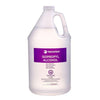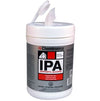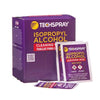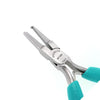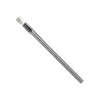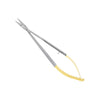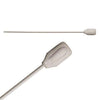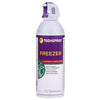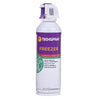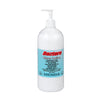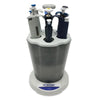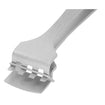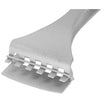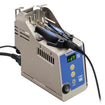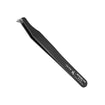- No products in the cart.
Methods of Making Thin Films for Solar Cells: The Best Cleaners and Tools for the Fabrication Processes
Jun
13
2020
Making thin films for solar cells is a compex, multistep process that requires precise actions, clean surfaces, and accurate tools. In this post, we will discuss important considerations in the methods of making thin films and give a thorough review of the tools and cleaners for your fabrication process to help you achieve your manufacturing goals.
Standard Methods of Making Thin Films
The process of manufacturing thin films begins with a substrate, often glass. This substrate is prepared with cleaning to remove any debris, followed by etching. Next, the thin film material, often amorphous silicon, is deposited onto the substrate in a plasma enhanced chemical vapor deposition (PECVD) before being patterned, coated, cleaned, wired, and finished.
Lack of precision at any of these steps can lead to decreased efficiency of the final solar cell product. Etching should be reproducible and accurate, leaving behind no residue. Deposition should be well regulated and performed on a clean substrate to reduce imperfections leading to gaps in conductance. Cutting, wiring, and all movements should be precise, accurate, and clean in order to manufacture a perfect thin film solar cell every time.
Contaminants Decrease Solar Cell Efficiency
Trapped contaminants like etching residue or water can lower the efficiency of your thin film solar cell. In order to achieve the highest efficiency thin film, your process should leave your cell free of contaminants at each step.
After any processing step occurs, you should implement a cleanup step. Examples of this can include rinsing with solvents, drying with air or heat, or wiping to remove dust as appropriate for your materials. Likewise, each step in the process should be bookmarked with quality checks (discussed in more detail later on in this post).
Often, these quality checks may involve the use of microscopes to determine if there are trapped contaminants in microscopic indents made as part of the manufacturing process. If you notice contaminants are a problem after a particular process, add a cleaning step with cleaning products appropriate for your materials.
Including a de-contamination after each processing step will reduce residues that decrease contacts in the cell, eating into the efficiency of the final product. In addition to de-contamination, maintaining a clean working environment can dramatically reduce the amount of contaminants in the first place.
Keep surfaces clean and dust-free with regular cleaning and wiping. Encourage employees to keep their work surfaces relatively clear of debris other than what is immediately required. These additional “clean home” tactics can dramatically reduce re-work associated with de-contamination of your products.

The Right Tools Make a Job Well Done
The tools you use in the manufacture of thin films are also crucial as to handle your products with accuracy and precision, without causing damage. When working with small parts, tweezers allow you to manually handle your materials.
Carefully consider the materials and features of tweezers. Metal tweezers are more rigid, while plastic tweezers are softer. When handling materials that shouldn’t be scratched or damaged, plastic may be preferable. However, when handling materials that require a strong grip or can withstand heat, metal would better serve your purpose. Some metal tweezers come coated and can serve both purposes. Likewise, tweezers come in all shapes and sizes, each one with a different purpose. Choose your handling tools like tweezers wisely to ensure your material is treated appropriately.
Many methods of making thin films also require the use of cutters for the manufacture of solar cells. Much like tweezers, cutters come in all shapes and sizes depending on their purpose. Cutters can accommodate precise angles, lengths, and spatial restrictions. Whether for cutting wire or sheets, cutters are designed for particular uses. Many cutters are made from high-carbon steel, a hard metal appropriate for machining soft metals like brass, steel, copper, and gold.
Depending on the task you want to accomplish you may have different requirements. Perhaps you need ESD (electrostatic discharge)-safe grip material? A particular cutting capacity (e.g. 0.001” - 0.020”)? A cutter designed for cutting soft wire? Selecting the appropriate cutting tools can ensure your work is completed precisely and efficiently.
Quality Control Reduces Waste
As mentioned when discussing contaminants in the manufacturing process, it is essential to monitor your product as it’s being produced. Each step should enlist a designated person or machine for quality checks. Quality checks would include not only monitoring for contaminants, but also for accuracy in etching, thin film deposition, patterning, and more. It is easier to amend a problem caught during manufacturing rather than after production has completed.
A quality check station should include the appropriate tools to assess your product as it is made. For small microscopic patterns, a microscope would be ideal. In larger-scale processing steps, magnifiers may be sufficient. Good quality control is a simple way to increase your manufacturing efficiency, reduce waste, and minimize rejected products.
How to look for a supplier of cleaning agents and tools
The methods of making thin films require precision and quality. The tools and processes discussed in this post aim to help you achieve this. However, where you get these tools from matters just as much as the tools and cleaners themselves. A knowledgeable supplier will be able to discuss your needs to help you decide the appropriate tools and cleaners for the job. Working with a supplier you can count on will help you achieve your thin film manufacturing goals. Make sure you qualify your supplier, the Laboratory Product Association has a list of suppliers that can help.
__
For over 40 years, Lab Pro has been committed to delivering the highest quality products, cutters, tweezers, microscopes, and cleaning solutions to solar panel production laboratories worldwide. Come visit the biggest Lab Supply showroom in the Bay Area, or contact us online or at 888-452-2776.
Reference:
http://www-inst.eecs.berkeley.edu/~ee143/fa10/lectures/Lec_26.pdf







